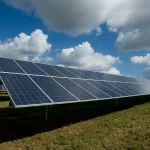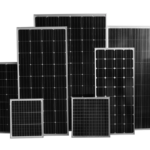- China’s Photovoltaic Export Tax Rebate Reduction May Lead to Module Price Increases
- Current Solar Panel Prices in Europe Drop Below 6 Cents per Watt
- France to Install Approximately 1.35 GW of Photovoltaic Capacity in Q3 2024
- Trump’s Upcoming Tariffs Could Lead to Surge in Imports and Rising Transport Costs
China’s Photovoltaic Export Tax Rebate Reduction Could Drive Module Price Increases

The Chinese Ministry of Finance and the State Taxation Administration recently announced a reduction in photovoltaic product export tax rebates, effective December 1. The rebate for solar cells (HS code 85414200) and solar modules (HS code 85414300) will decrease from 13% to 9%. This adjustment means that Chinese exporters will see a reduction in their rebate income, potentially impacting their profit margins. To offset this loss, companies may consider raising export prices.
While this change will have a minimal direct impact on the production costs for photovoltaic manufacturers, market research firm Shanghai Nonferrous Metals Market (SMM) suggests that the move could help stabilize overseas market prices and may contribute to a market rebound. Whether prices rise will largely depend on supply and demand conditions in different regions.
This adjustment comes amid the expansion of China’s photovoltaic industry capacity, while the prices of photovoltaic products have been continuously declining for a year. As of October, the domestic price of solar modules had dropped to RMB 0.62 per watt (approximately 8.1 cents), a price deemed below production costs, raising concerns that this price level may not be sustainable.
To avoid further price declines and mitigate potential financial losses, the China Photovoltaic Industry Association (CPIA) held a closed-door meeting with major manufacturers and state-owned energy companies in October. The meeting resulted in a consensus to set a “floor price” for solar panels at RMB 0.68 per watt (approximately 8.9 cents). This move aims to prevent unhealthy price competition, with state-owned electric companies agreeing not to accept bids below this price in key tenders, and manufacturers agreeing to maintain this floor price.
Wang Shujuan, founder of Zhihui Photovoltaics, stated that the reduction in tax rebates would support the CPIA’s strategy to stabilize prices in international markets. Some industry analysts point out that reducing export rebates is part of China’s long-term photovoltaic strategy. As China’s market share of global photovoltaic products increases, the government may eventually phase out export tax rebates entirely. Analysts believe that the reduction from 13% to 9% could be just the beginning, with more policy adjustments likely in the future.
Current Solar Panel Prices in Europe Drop Below 6 Cents per Watt

Solar panel prices in Europe hit a new low this week, reaching 5.5 euro cents per watt, breaking the historical minimum. This significant price drop was facilitated through the solar procurement and sales platform Search4Solar, signaling a major shift in the market.
Leen Van Bellen, European Business Development Manager at Search4Solar, commented: “For the first time, we’ve witnessed the breaking of the 6.0 euro cents per watt price floor.” He believes that for companies and installers looking to invest in sustainable energy, the current prices present an excellent opportunity. “This means our customers can now purchase high-quality solar panels at unprecedentedly low prices, helping them achieve their sustainability goals at a lower cost.”
Van Bellen added that the recent price reductions have not been gradual but rather marked by more dramatic price drops. “We’ve noticed that suppliers are eager to reduce stock, which is driving prices to become more competitive. Early price reductions by manufacturers have stimulated demand, sparking a buying spree in the market,” he explained. “However, this also means that other manufacturers will have to lower prices further to remain competitive. The rapid reduction in stock may lead to a rebalancing of supply and demand.”
According to Search4Solar’s analysis, several factors are contributing to the downward trend in solar module prices, including high production utilization rates, improvements in supply chain efficiency, and increased market competition. Suppliers have broadly adopted price-cutting strategies to balance inventory and meet demand.
Van Bellen stated that the price drop below 6.0 euro cents per watt may indicate that the European solar module market has reached its bottom. “This is the lowest point for the EU market,” he said. “Going forward, some products may be redirected to China or exported to Africa.”
In the short term, Search4Solar expects solar module prices to remain low, but this trend could quickly reverse as market supply and demand dynamics shift. “For customers looking to take advantage of this price advantage, now is a once-in-a-lifetime opportunity. With prices at historic lows, this is the ideal time to invest in solar energy,” Van Bellen emphasized. “This provides a rare opportunity for installers and project developers to save on costs while making sustainable energy more accessible to more customers.”
Additionally, according to the latest data from OPIS, prices for Topcon solar panels have fluctuated significantly this week, ranging from 8 euro cents to 12 euro cents per watt, with the average price settling at 10.1 euro cents per watt.
France to Install Approximately 1.35 GW of Photovoltaic Capacity in Q3 2024

According to the latest report from French grid operator Enedis, France is set to add approximately 1,351 MW of photovoltaic capacity in Q3 2024. For the first three quarters of this year, total new capacity has reached 3,328 MW, surpassing last year’s total new installations of 3,135 MW.
Notably, the growth momentum for commercial rooftop solar systems has been exceptionally strong. The installation capacity for small businesses surged from 318 MW in Q1 to 547 MW in Q3, marking a 72% growth rate.
Enedis also revealed that over 1 million renewable energy systems have now been connected to the French grid, the majority of which are photovoltaic systems. In Q1 of this year, 56,504 new systems were grid-connected, followed by 63,757 systems in Q2, and 64,448 systems in Q3.
Enedis pointed out that the rapid growth is largely driven by the surge in consumer interest, particularly among individual users and small businesses. “In the past two years, the number of self-consumption customers who choose local energy production has more than doubled, now exceeding 610,000,” explained Enedis.
Trump’s Upcoming Tariffs Could Lead to Surge in Imports and Rising Transport Costs

According to the latest warning from Norwegian maritime and freight benchmark platform Xeneta, spot freight rates for container shipping could rise due to the re-election of Donald Trump as U.S. President. Xeneta’s statement noted that Trump has vowed to impose tariffs of up to 20% on all imports to the U.S., particularly targeting goods from China, with additional tariffs potentially reaching 60% to 100%.
The company recalled the situation during Trump’s previous trade war in 2018, when high tariffs on Chinese goods caused container shipping costs to surge by over 70%. “According to Xeneta’s data, when Trump raised tariffs at that time, freight costs for container shipping skyrocketed,” the company noted.
Xeneta also pointed out that U.S. importers and exporters are accelerating procurement in anticipation of potential increases in shipping rates. The company expects that the preparatory work for this trade war will play a significant role in preventing the chaos of 2018 from repeating itself.
Xeneta’s chief analyst, Peter Sand, told PV Magazine that shipping supply chain professionals have been dealing with changing risk management challenges in recent months. “First, there were strikes at U.S. East Coast and Gulf Coast ports, followed by the impact of the U.S. presidential election,” he explained. “As the uncertainty of the election results fades, the focus is shifting toward executing contingency plans and preparing for the transition to a new round of tariff regimes.”
Sand further explained that U.S. retailers have proactively stocked up in the past year to mitigate potential supply chain disruptions, giving importers some strategic maneuvering space. He pointed out that there are currently no signs that freight activity will spike significantly.
He added, “Spot container shipping rates, especially from the Far East/China to the U.S. East Coast, have recently risen by $150 per 40-foot equivalent unit, while West Coast rates have also seen a similar decline in the past three months.”
In the first half of 2024, shipping costs surged due to the Red Sea crisis. Sand noted, “The potential for early loading and strikes at U.S. East Coast and Gulf Coast ports is increasing.”
Xeneta also warned that other countries and trade groups, particularly the EU, may also impose tariffs, which could further drive up international shipping costs. The company highlighted that “monitoring container shipping data for backhaul trade is becoming increasingly important, as a global trade war could affect these data points as well.”
Xeneta emphasized that the escalation of trade wars could force some shippers to adjust their supply chains and import goods to the U.S. via alternative routes. Specifically, they may opt to set up production facilities in other Far East countries, but this process would be time-consuming and costly.
Since 2008, Maysun Solar has been committed to delivering high-quality agrivoltaic solutions that support sustainable agriculture and help tackle climate change. Our innovative IBC, HJT, TOPCon, and Bifacial solar modules are designed for outstanding efficiency and durability, enabling long-lasting performance in agrivoltaic environments. With established offices and warehouses across multiple countries and trusted partnerships with leading installers, we provide comprehensive support for seamless integration of agrivoltaics into farming practices. For the latest quotes or inquiries related to agrivoltaic systems, please feel free to contact us—we’re here to support your journey towards greener, more efficient farming.
Reference:
Deboutte, G. (2024, November 1). Frankreich installiert im dritten Quartal 2024 rund 1,35 Gigawatt Photovoltaik. Pv Magazine Deutschland. https://www.pv-magazine.de/2024/11/01/frankreich-installiert-im-dritten-quartal-2024-rund-135-gigawatt-photovoltaik/
Bellini, E. (2024, November 19). Looming Trump tariffs drive rush on imports, push shipping costs higher. Pv Magazine International. https://www.pv-magazine.com/2024/11/19/looming-trump-tariffs-drive-rush-on-imports-push-shipping-costs-higher/
Shaw, V. (2024, November 19). Senkung der chinesischen Photovoltaik-Exportsteuerrabatte könnte zu höheren Modulpreisen führen. Pv Magazine Deutschland. https://www.pv-magazine.de/2024/11/19/senkung-der-chinesischen-photovoltaik-exportsteuerrabatte-koennte-zu-hoeheren-modulpreisen-fuehren/
Bellini, E. (2024a, November 14). Solarmodule werden in Europa jetzt für weniger als sechs Cent pro Watt verkauft. Pv Magazine Deutschland. https://www.pv-magazine.de/2024/11/14/solarmodule-werden-in-europa-jetzt-fuer-weniger-als-sechs-cent-pro-watt-verkauft/

Empowering Factories with Solar Energy A Strategic Tool for Controlling Production Electricity Costs
Commercial and industrial solar is becoming a key solution for factories to reduce electricity costs and hedge against price fluctuations. This article systematically analyzes its deployment models, cost advantages, and sustainable value pathways.

How Businesses Can Offset Carbon Taxes with Solar Power
This article analyzes the latest carbon tax policies and photovoltaic deduction strategies, helping European businesses legally reduce taxes, increase profits through solar investment, and achieve a win-win situation for both economy and environment.

Forecast and Response: Seizing the Next Decade’s Growth Dividend in Europe’s Commercial and Industrial Photovoltaics Market
Maysun Solar analyzes the growth trends of commercial and industrial photovoltaics in Europe over the next ten years, from policies and ESG to technological innovation, helping companies seize the initiative in the energy transition.

How to Calculate Solar System ROI and Optimize Long-Term Returns?
Solar power is becoming a key solution for businesses to reduce costs and improve efficiency. Accurately calculating ROI and optimizing long-term returns are essential to maximizing investment value.

Will Agrivoltaics Affect Crop Growth?
Agrivoltaics combines solar energy and agriculture to reduce up to 700 tons of CO₂ per MW, improve water use, and boost crop growth for sustainable farming.

6.5 Billion Loss Hits Photovoltaics: Reshaping or Elimination?
In 2025, the photovoltaic market may see a turnaround as some companies take early action. A €6.5 billion loss is driving businesses to explore new growth areas like energy storage and hydrogen. Which giants will break through? Industry transformation is accelerating!



